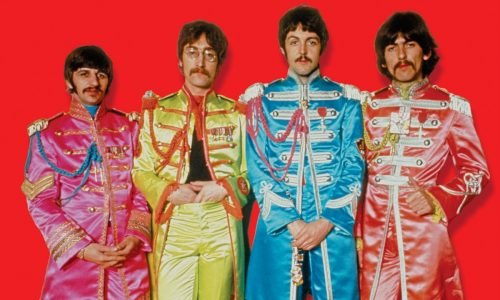Released in 1967, ‘Sgt. Pepper’s Lonely Hearts Club Band‘ by The Beatles is widely regarded as one of the most groundbreaking albums in the history of popular music. This seminal work not only defined the Summer of Love but also marked a revolutionary shift in how albums were perceived and produced. By embracing innovative studio techniques, eclectic musical styles, and a concept album approach, The Beatles transcended the traditional boundaries of rock music, setting a new standard for artistic expression and album craftsmanship. Its blend of psychedelia, vaudeville, and classical influences, coupled with thought-provoking lyrics, cemented ‘Sgt. Pepper’ as a cultural milestone that continues to influence musicians and artists across generations.
Conceptualization
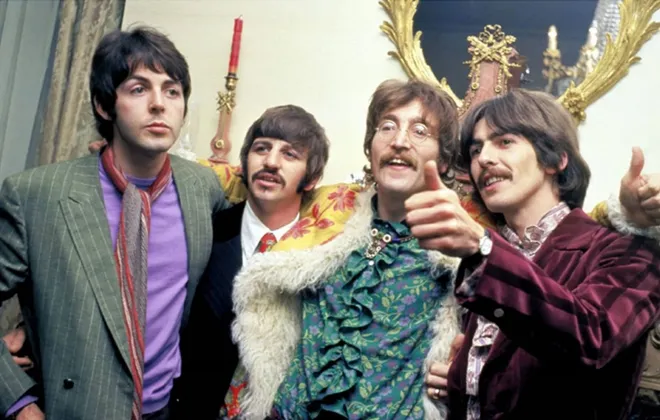
Inspiration
The seeds of ‘Sgt. Pepper’s Lonely Hearts Club Band’ were sown during The Beatles’ break from touring in late 1966. Freed from the pressures of constant performance, the band members found themselves with the luxury of time to experiment and reflect. Paul McCartney, in particular, spearheaded the concept for the album. Inspired by the burgeoning counterculture movement and the avant-garde artistic trends of the time, McCartney envisioned an album that would serve as a musical journey, much like a theatrical performance. The idea of creating an alter ego band, ‘Sgt. Pepper’s Lonely Hearts Club Band,’ allowed The Beatles to explore new artistic identities and gave them the creative freedom to push the boundaries of their music.
The inspiration for the album’s eclectic sound came from various sources, including contemporary artists like The Beach Boys and their album ‘Pet Sounds,’ which impressed McCartney with its innovative production and complex arrangements. Additionally, the growing influence of psychedelic drugs, particularly LSD, played a significant role in shaping the album’s otherworldly and surreal quality. The Beatles sought to capture the spirit of their times, blending their musical prowess with a kaleidoscope of sounds and ideas that reflected the rapidly changing cultural landscape.
Band’s Vision
The Beatles’ vision for ‘Sgt. Pepper’ marked a significant departure from their previous work. While earlier albums like ‘Rubber Soul‘ and ‘Revolver‘ had already shown a clear evolution in their musical style, ‘Sgt. Pepper’ was conceived as a fully immersive experience. Instead of a collection of individual songs, the album was designed as a cohesive whole, with each track flowing seamlessly into the next. This concept album approach was groundbreaking, establishing a new paradigm in popular music.
The band wanted to create a record that was not only sonically innovative but also visually and thematically cohesive. The use of a fictional band allowed them to adopt a more experimental approach, unrestrained by their established image. They embraced a diverse range of musical genres, from rock and roll to Indian classical music, blending them into a rich tapestry that defied categorization. The Beatles’ vision extended beyond the music to the album cover, a vibrant collage of cultural icons that encapsulated the eclectic and inclusive spirit of the project.
Songwriting Process
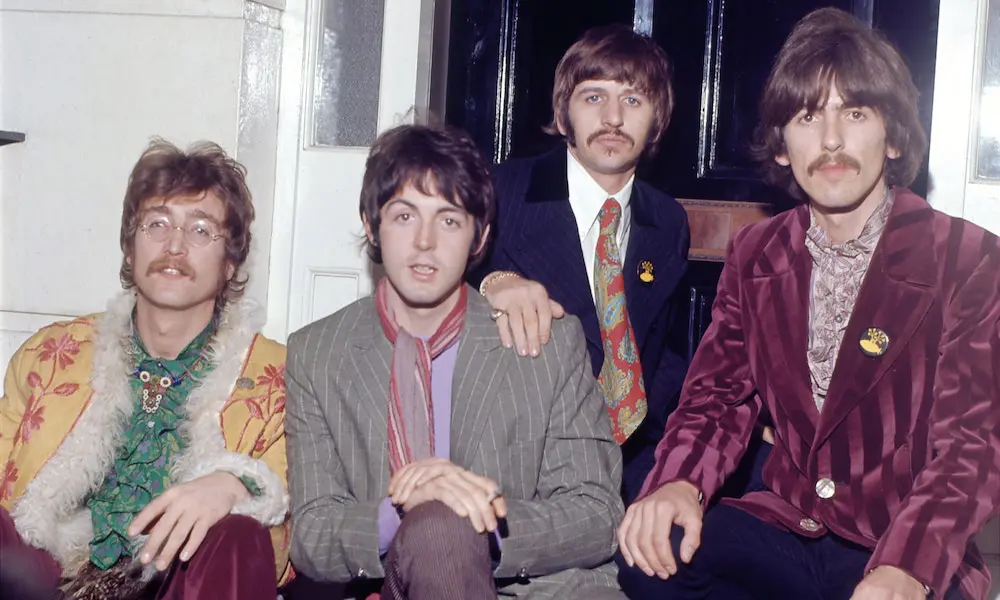
Collaborative Efforts
The songwriting process for ‘Sgt. Pepper’s Lonely Hearts Club Band’ was a testament to the collective genius of The Beatles. While John Lennon and Paul McCartney continued to be the primary songwriters, the album saw significant contributions from George Harrison and even Ringo Starr, each bringing their unique perspectives and talents to the table. The collaborative dynamic was marked by a spirit of experimentation and mutual influence, as the band members pushed each other to explore new creative territories.
Paul McCartney’s role in conceptualizing the album gave him a prominent influence over its direction. His meticulous approach and melodic sensibilities are evident in tracks like “Sgt. Pepper’s Lonely Hearts Club Band” and “When I’m Sixty-Four.” McCartney’s knack for crafting catchy, yet sophisticated tunes provided a structural backbone for the album.
John Lennon, on the other hand, brought a contrasting, often more introspective and surreal edge to the project. His contributions, such as “Lucy in the Sky with Diamonds” and “A Day in the Life,” showcased his ability to blend vivid imagery with evocative melodies, adding depth and complexity to the album’s narrative.
George Harrison’s input was equally vital, with his interest in Indian music and spirituality culminating in the mesmerizing track “Within You Without You.” This song not only broadened the album’s sonic palette but also introduced Western audiences to the intricacies of Indian classical music.
Even Ringo Starr stepped into the spotlight, providing the vocals for “With a Little Help from My Friends,” a song written by Lennon and McCartney that perfectly captured his affable personality. Starr’s steady drumming and distinctive vocal delivery added a layer of warmth and camaraderie to the album.
Lyric Themes
The lyrics of ‘Sgt. Pepper’s Lonely Hearts Club Band’ are rich with recurring themes and messages that reflect the band’s evolving worldview and the zeitgeist of the 1960s. One prominent theme is the exploration of identity and alter egos. By adopting the persona of Sgt. Pepper’s band, The Beatles were able to step outside their established identities and experiment with new artistic expressions, as seen in songs like “Sgt. Pepper’s Lonely Hearts Club Band” and “Lovely Rita.”
Another key theme is the embrace of psychedelia and the mind-expanding experiences associated with it. This is vividly depicted in songs like “Lucy in the Sky with Diamonds,” which uses surreal and dreamlike imagery to evoke a sense of otherworldly exploration. The influence of psychedelic drugs is also apparent in “A Day in the Life,” where fragmented narratives and unconventional structures mirror the altered states of consciousness.
Nostalgia and reflection are also recurring motifs. Tracks like “When I’m Sixty-Four” and “She’s Leaving Home” touch on themes of aging, memory, and the passage of time. These songs offer poignant reflections on personal and societal changes, resonating with listeners on an emotional level.
Furthermore, the album addresses themes of love and friendship, as exemplified by “With a Little Help from My Friends.” This song, in particular, underscores the importance of camaraderie and mutual support, a sentiment that was especially significant during a time of social upheaval.
Recording Sessions
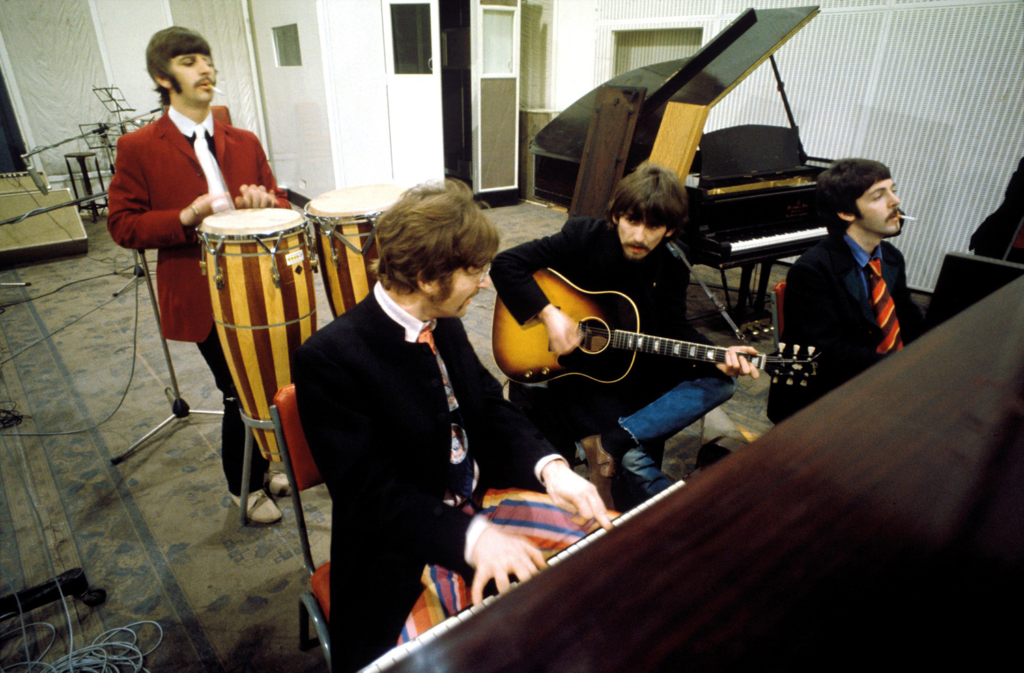
Studio Innovations
The recording sessions for ‘Sgt. Pepper’s Lonely Hearts Club Band’ were a hotbed of innovation, pushing the boundaries of what was possible in the studio. The Beatles, together with their producer George Martin and engineer Geoff Emerick, utilized an array of groundbreaking techniques that redefined the art of recording.
One of the most significant innovations was the use of multi-tracking. By layering multiple recordings, The Beatles could create complex, richly textured soundscapes. This technique was crucial for songs like “A Day in the Life,” where orchestral crescendos and intricate arrangements demanded meticulous layering. The band also made extensive use of varispeed recording, which involved altering the speed of tape machines during recording and playback to change the pitch and tempo of the music. This technique was employed to achieve the whimsical, high-pitched vocals in “When I’m Sixty-Four.”
The use of unconventional instruments and sounds was another hallmark of the ‘Sgt. Pepper’ sessions. The album features a diverse array of instruments, including sitars, harmoniums, and tape loops, which added to its eclectic and experimental nature. For example, the distinctive opening guitar riff of “Lucy in the Sky with Diamonds” was achieved using a combination of effects and precise microphone placement.
Geoff Emerick’s innovative engineering techniques played a crucial role in shaping the album’s sound. He pioneered the use of close-miking techniques for drums, capturing a more immediate and punchy sound. Additionally, Emerick’s willingness to experiment with microphone placement and recording environments led to unique sonic textures, such as the swirling effects in “Being for the Benefit of Mr. Kite!” which were created using tape loops of calliope music.
Key Personnel
The making of ‘Sgt. Pepper’s Lonely Hearts Club Band’ was a collaborative effort that involved several key figures who contributed their expertise and creativity to the project.
George Martin, Producer: Often referred to as the “fifth Beatle,” George Martin’s role as producer was instrumental in bringing the band’s ambitious ideas to fruition. His classical music background and technical knowledge allowed him to translate The Beatles’ creative visions into reality. Martin’s orchestral arrangements and his ability to blend diverse musical elements were pivotal in creating the album’s signature sound. His guidance and innovative approach to studio production were essential in pushing the boundaries of what could be achieved in a recording studio.
Geoff Emerick, Engineer: At just 19 years old, Geoff Emerick took on the role of chief engineer for the ‘Sgt. Pepper’ sessions. His fresh perspective and willingness to experiment were crucial in capturing the album’s groundbreaking sound. Emerick’s engineering techniques, such as the close-miking of Ringo Starr’s drums and the use of tape loops and artificial double tracking (ADT), added new dimensions to the recordings. His inventive use of studio technology helped create the album’s distinctive audio landscape.
Other Contributors: While Martin and Emerick were central to the recording process, other individuals also played important roles. Mal Evans, The Beatles’ road manager, contributed sound effects and even played instruments on some tracks. Session musicians, such as the orchestra members on “A Day in the Life,” brought their expertise to the album, adding depth and complexity to the arrangements.
Album Artwork
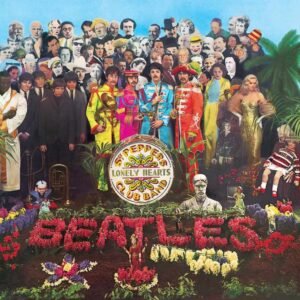
Design Concept
The album cover for ‘Sgt. Pepper’s Lonely Hearts Club Band’ is one of the most iconic and recognizable in music history, embodying the eclectic and avant-garde spirit of the 1960s. The concept behind the cover was to create a vibrant, collage-like tableau that represented the fictional band and their audience, a diverse gathering of famous figures from various walks of life.
Paul McCartney played a significant role in envisioning the cover. He wanted it to reflect the album’s eclectic nature and the alter ego of Sgt. Pepper’s band. The idea was to create a snapshot of a colorful, celebratory scene that captured the zeitgeist of the era. The Beatles, dressed in flamboyant military-style uniforms, stand at the center, surrounded by a crowd of people from different time periods and backgrounds, symbolizing the broad cultural influence and the breaking down of traditional barriers.
The cover also features a mix of real and fictional characters, blurring the lines between reality and imagination, much like the music on the album. The Beatles themselves are shown twice: once in their Sgt. Pepper’s costumes and again as wax figures from their early days, emphasizing their transformation and evolution as artists. The vibrant, almost surreal backdrop and the use of vivid colors reflect the psychedelic influence that permeated much of the band’s work during this period.
Artists Involved
The innovative design of the ‘Sgt. Pepper’ album cover was brought to life by British pop artists Peter Blake and Jann Haworth. Their expertise in creating visually striking and culturally resonant art made them the perfect choice to execute McCartney’s vision.
Peter Blake: Blake is renowned for his work in the pop art movement, which often incorporates imagery from popular culture and mass media. For the ‘Sgt. Pepper’ cover, Blake was instrumental in selecting the array of figures that populate the scene. His ability to blend high and low art, and to create a sense of depth and narrative within a single image, was crucial in making the cover both visually engaging and thematically rich.
Jann Haworth: An American artist and sculptor, Haworth collaborated closely with Blake on the cover’s design. Her contributions included creating some of the three-dimensional elements of the collage, such as the fabric and sculptural components that give the cover its distinctive texture and layered appearance. Haworth’s background in sculpture added a tactile quality to the artwork, enhancing its visual complexity and appeal.
Together, Blake and Haworth meticulously assembled the cover using photographs, cut-outs, and various props, creating a dense and detailed scene that invites viewers to explore and discover. The inclusion of notable figures—from cultural icons like Marilyn Monroe and Bob Dylan to historical figures like Karl Marx and Albert Einstein—reflects the album’s thematic diversity and the band’s wide-ranging influences.
Cultural Impact
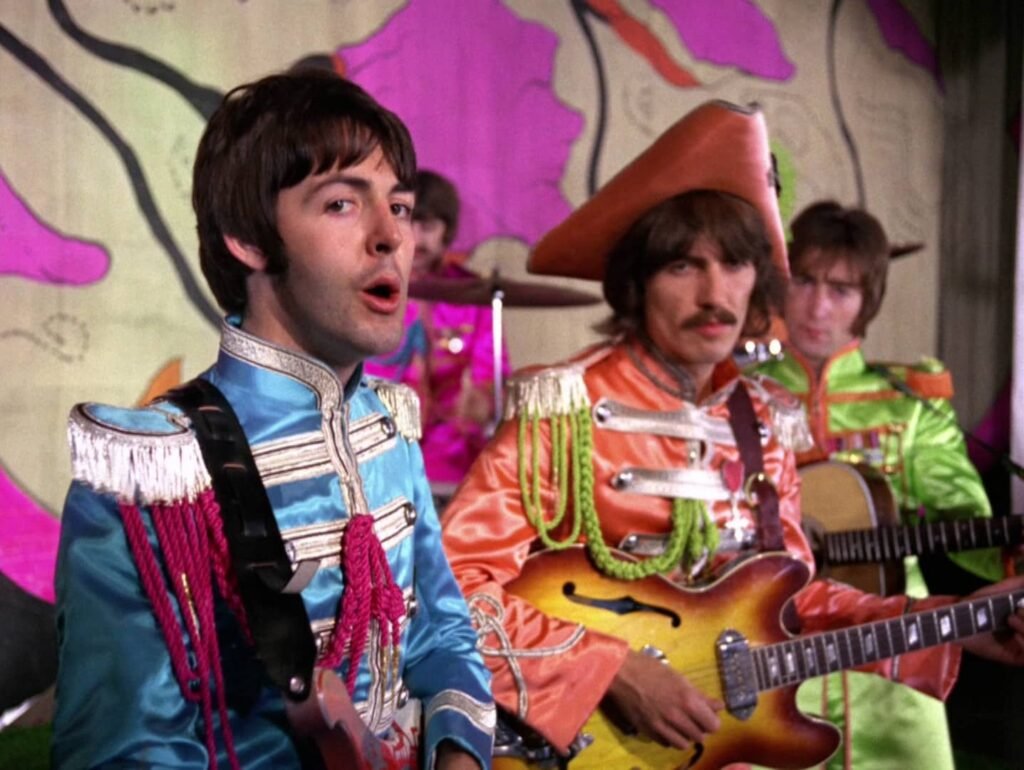
Initial Reception
Upon its release on June 1, 1967, ‘Sgt. Pepper’s Lonely Hearts Club Band’ received unprecedented critical and commercial acclaim. The album was hailed as a groundbreaking masterpiece, instantly redefining the possibilities of popular music. Critics praised its innovative production, eclectic sound, and conceptual coherence. Publications such as The Times and Rolling Stone lauded it as a significant leap forward in the evolution of rock music.
The album’s adventurous spirit and sophisticated artistry resonated deeply with listeners, catapulting it to the top of the charts worldwide. In the UK, it remained at number one for 23 consecutive weeks, and in the US, it topped the Billboard 200 for 15 weeks. The commercial success was matched by widespread admiration from both fans and musicians, cementing The Beatles’ reputation as pioneers in the music industry.
Long-term Influence
The long-term influence of ‘Sgt. Pepper’s Lonely Hearts Club Band’ on music and pop culture is profound and far-reaching. It is often credited with elevating the album format from a mere collection of songs to a cohesive artistic statement. This shift encouraged artists across genres to explore concept albums and thematic projects, leading to an era of more ambitious and innovative musical creations.
The album’s experimental approach to studio techniques, including multi-tracking, varispeed recording, and the use of non-traditional instruments, has inspired countless musicians and producers. Bands like Pink Floyd, The Beach Boys, and Radiohead have cited ‘Sgt. Pepper’ as a pivotal influence on their work. The album’s fusion of diverse musical styles, from rock and classical to Indian music, has also encouraged artists to embrace genre-blending and cross-cultural experimentation.
Culturally, ‘Sgt. Pepper’ became synonymous with the 1960s counterculture movement, embodying the era’s spirit of exploration, freedom, and social change. Its themes of identity, community, and introspection resonated with the youth of the time and continue to be relevant today. The album cover itself has become an iconic image, symbolizing the vibrant and transformative nature of the decade.
Legacy
Awards and Accolades
‘Sgt. Pepper’s Lonely Hearts Club Band’ has garnered numerous awards and accolades since its release, solidifying its status as one of the greatest albums of all time. Notable recognitions include:
Grammy Awards: In 1968, the album won four Grammy Awards, including Album of the Year, making The Beatles the first rock band to receive this honor.
Rolling Stone: In 2003, Rolling Stone magazine ranked it number one on its list of the 500 Greatest Albums of All Time.
The Rock and Roll Hall of Fame: The album was inducted into the Grammy Hall of Fame and is featured in the Rock and Roll Hall of Fame’s list of the 500 Songs That Shaped Rock and Roll.
Continued Relevance
The continued relevance of ‘Sgt. Pepper’s Lonely Hearts Club Band’ can be attributed to its timeless themes, innovative production, and cultural significance. Its exploration of identity, community, and the human experience remains pertinent, resonating with new generations of listeners. The album’s willingness to push artistic boundaries and embrace experimentation serves as a source of inspiration for contemporary musicians seeking to innovate and express their creativity.
Moreover, the album’s impact on the music industry cannot be overstated. It demonstrated the potential of the studio as an instrument, influencing how music is produced and recorded. The Beatles’ collaborative spirit and dedication to their craft set a benchmark for artistic integrity and excellence.
‘Sgt. Pepper’s Lonely Hearts Club Band’ remains a touchstone in the world of music, a testament to The Beatles’ visionary artistry and their ability to capture the zeitgeist of their time while creating something truly timeless. As long as there is a fascination with the possibilities of music and the power of artistic expression, ‘Sgt. Pepper’ will continue to be celebrated and revered.
